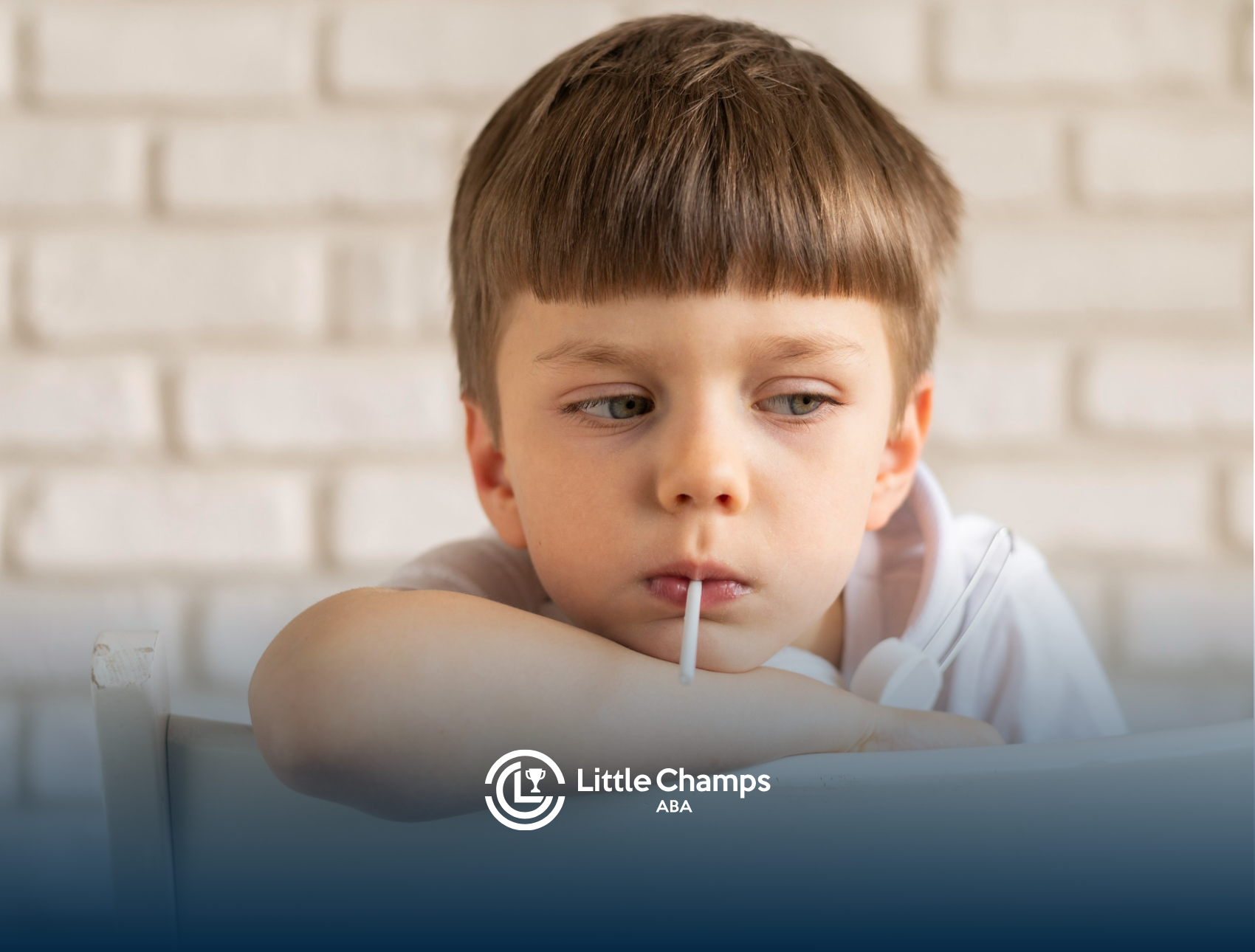
Key Highlights
In a world where understanding the complexities of neurodiversity is becoming increasingly important, Pica—a condition characterized by the craving to eat non-food items—poses unique challenges, especially for individuals with autism. This blog aims to illuminate the intricate relationship between Pica and autism, shedding light on its symptoms, causes, and the impact it can have on both individuals and their families. We’ll delve into effective management strategies that can help navigate this condition while enhancing quality of life. Whether you’re a caregiver, educator, or simply someone seeking knowledge in this area, our exploration will provide valuable insights and practical approaches to tackle Pica head-on. Join us as we uncover the layers of this often-misunderstood behavior and empower ourselves with information that can make a difference.
Introduction
Pica behavior is a hard thing to understand, and it can be very serious. It often shows up with autism spectrum disorder and other developmental disabilities. This means that some people feel the need to eat things that are not food. They might eat dirt, paper, or hair. This can cause a lot of problems for them, like medical issues. It also affects their social life and emotions, and it can be tough on their families too. Pica is not only seen in those with autism, but it is very common in people who have developmental disabilities. It helps to know what this behavior is and what causes it. Learning about strong ways to handle it can make things better for the person and those around them.
Defining Pica and Its Relevance to Autism
Pica is when someone eats things that are not food. This happens a lot in people with developmental disorders such as autism. Pica behavior can be caused by the way someone feels things, also known as sensory input. It can also happen because of other health problems. This behavior is not just a strange habit. The risks are serious for health.
Studies show the prevalence of pica is much higher in people with autism spectrum disorder. Around 23.2% of autistic children have pica behavior, while only 3.5% of kids in the general population do. When you know about the connection between developmental disorders like autism spectrum disorder and pica, you can better plan ways to help.
What Is Pica?
Pica is when a person keeps eating things that are not food for at least one month. These things can be soil, paint, hair, or even dangerous objects like screws or rubber pieces. This kind of eating is not right for any age and often happens in people with developmental disabilities, like autism.
Pica behavior sometimes happens because people want to feel something from the things they eat. Some people like the way dirt or stones feel in their mouth. This can happen when a person is looking for a certain taste or touch that food items usually do not have. Sensory input from these non-food things can make a person feel good.
Pica behavior can be very serious. It can lead to dangerous health issues like choking, not getting enough nutrients, or even lead poisoning. Knowing the reasons for this, like sensory input or medical issues, helps people make better plans to support those who have pica.
How Common Is Pica in Individuals with Autism?
Pica is disproportionately common among individuals with autism spectrum disorder and developmental disabilities. Research reveals that around 23.2% of children with autism engage in pica, a stark contrast to only 3.5% in the general population. Prevalence increases further among autistic adults, reaching up to 60%.
| Population Group | Prevalence of Pica (%) |
|---|---|
| General Population | 3.5% |
| Children with Autism | 23.2% |
| Adults with Autism | 60% |
| Children with Autism & ID | 28.1% |
| Children with Autism, without ID | 14% |
This data highlights the need for targeted assessments and interventions tailored to unique sensory and medical needs within the autistic population.
Recognizing the Signs and Symptoms of Pica
Timely recognition of pica behavior is very important to help prevent serious health problems. Some common signs are eating, wanting, or thinking a lot about things that are not food items, like soil, paper, or plastics. Many parents and caregivers can be confused when they see these acts.
Healthcare providers have a big part in finding pica behavior. They can notice signs and talk with families to help. They try to learn what makes someone eat non-food items, when it happens, and if there are other health issues. All of this helps healthcare providers find good ways to step in and protect the person’s well-being.
Typical Behaviors and Warning Signs
Pica often shows up through some clear signs that caregivers can spot. These include:
- Eating or chewing things that are not food items, like paint, dirt, or plastics, over and over again.
- Focusing a lot on how something feels, or enjoying sensory input from things like sand or paper.
- Being very interested in certain things you can’t eat, and sometimes trying again and again to get them.
- Having problems like choking, upset stomach, or harm to the teeth and mouth.
- Getting upset or anxious after someone tries to stop this behavior.
Many people take part in pica because they need certain sensory input, or they may not know what is okay to eat. This is why healthcare providers will look for these signs and keep track of them.
Potential Health Risks and Complications
The effects of pica can be very serious and should not be ignored. Lead poisoning is a major risk. It can happen when you eat things with bad chemicals in them. This risk is one of the hardest to deal with. Other problems can happen as well, like when sharp things block or tear the intestines. This only adds to the worry.
There is more to it. Some people who eat soil or poop often get sick from harmful bacteria and parasites. Even things that seem less harmful, like dirt or paper, can make people choke or not get the right food they need.
Healthcare providers say people who show signs of pica should have regular check-ups. These should have blood tests to look for lead poisoning, too. Doing this helps find out if something is wrong before it gets worse and helps keep people safe.
Exploring the Causes of Pica in Autism
What causes pica behavior in people with autism? Many of these people like to touch or taste things in their mouths, and this can make them eat things that are not food. Some may do this because their body needs more zinc, iron, or other nutrients that are good for health.
Developmental disorders can make the problem worse. People may want to feel different things, and this need can get stronger when they feel stress or worry. When caregivers and professionals know the root of pica behavior, they can find the right ways to help. These ways can work to stop eating things that are not food and to give the right sensory or nutritional support each person needs.
Sensory Needs and Sensory-Seeking Behaviors
For many people who are on the autism spectrum, pica behavior is a way to seek different feelings through the senses. They often eat things like dirt, paper, or rubber. These things have the kind of texture or taste that helps to fill a craving, mostly for how something feels in their mouth.
Some autistic children go through times when their senses feel off. During these times, they might chew or swallow things that are not food. This helps them feel a kind of comfort in their own way. When experts give these kids safe items to chew or feel, which fit the same kind of craving as pica, like trusted chew toys or objects with the same textures, it can help. Their stress can go down when they get the right kind of help.
Helping someone self-regulate by following a sensory diet or doing planned activities can really lower how often pica behavior happens.
Nutritional Deficiencies and Medical Factors
Nutritional problems are also a common reason for pica behavior in people with autism. When there is not enough iron, zinc, or other nutrients in the diet, people may start to want or eat things that are not food. Many studies show that giving the body what it needs through liquid multivitamins, antioxidant supplements, and special nutrient mixes can be helpful.
Health problems, such as trouble with digestion, can also be linked to pica behavior. Stomach problems can make someone want to chew or eat things that are not food to feel better. It is important to have expert checkups to find any body or stomach problems. This will help to stop pica behavior and help the individuals feel better.
Assessing and Diagnosing Pica in Autistic Children
Diagnosing pica behavior starts with looking at what someone does. This step needs a trained healthcare provider to watch and check the person carefully. The provider uses certain steps to see if the case should get treatment.
People caring for the person may fill out simple forms or answer questions. This is the first step in checking for pica behavior. Still, it helps a lot to keep track of how often it happens and what things start it. This closer watch gives better ideas about what the person needs. Catching pica behavior early is important. It helps reduce the dangers that can come with it if it goes on for too long.
Criteria for Diagnosis
To confirm if a person has pica, healthcare providers look for some clear signs:
- The person keeps eating things that are not food for at least one month.
- The person does this at an age when it is not normal to eat such things.
- The behavior cannot be explained by any cultural or socially accepted custom.
When someone has autism spectrum disorder, pica still needs special attention, even if the person has other mental health issues. The healthcare providers watch for what triggers the eating, what kind of actions and behaviors come up, and also what the nutritional needs are, so they can give support that fits the person.
Assessment Tools and Professional Evaluation
Structured assessments help make all the needed facts about pica behavior clear:
- Questionnaires give details from caregivers about what a person eats and what items they often go for.
- Behavioral logs show how often the behavior happens, what starts it, and when it takes place.
- Health evaluations look for signs of bad reactions, sickness, or problems with the body that may be the cause.
Healthcare providers use these tools to get a full picture of the behavior. This helps make sure their tips fit with each person’s background and stage of growth. When people in different fields work together, they help create the best plan for treatment.
Impact of Pica on Daily Life and Family Wellbeing
Pica is when someone eats things that are not food. The effects of pica reach further than that person. It also affects the daily life and feelings of the whole family. The family may have to watch the person all the time, make their home safer, and stay alert to risks. This can make things harder for people who care for someone with pica.
It is important to deal with pica to help bring normal life back to everyone at home. Taking action protects the health and the feelings of each loved one. Helping with pica can help family members feel less worried. It also helps families move toward safer and better ways of living.
Managing Safety Concerns at Home
Families need to do some things to lower the risks from pica:
- Keep harmful items locked up or out of common rooms where people gather.
- Check the home often to look for things that could cause harm and take them away.
- Give safe options to chew for kids who need sensory input.
- Make sure things like fuse boxes or cables are covered well and are safe.
- Watch stools to see if any pica items were swallowed by mistake.
When parents focus on keeping the space safe and use regular actions to distract, they help lower the dangers of pica a lot.
Emotional and Social Effects on Families
The emotional toll of pica on families is very real. It hurts to see someone you care about face risky or strong eating habits. People in the family can feel scared, upset, and not sure what to do.
Sometimes families spend less time out in public. It is not always easy to handle sensory input limits at new or crowded places. The feelings affect everyone, from siblings to parents to other family members, too. Getting help from support groups and talking to a counselor can help families deal with the hard parts. This way, families work together to keep everyone as safe and healthy as possible, while still looking after the person who has pica.
Effective Strategies for Managing Pica
Managing pica needs more than one plan. To help, people use both therapy and changes in behavior. Healthcare providers are part of this process. They give the right help to each person. Nutritional supplements help fix what is missing in the body because of this behavior. A sensory diet can give safe options instead of harmful items.
With support from family, these ways can lower pica actions. Over time, people can also learn better ways to deal with stress and handle their feelings.
Behavioral and Therapeutic Interventions
Behavioral therapies want to help with pica behavior by guiding people to use other safe options instead. Techniques such as “differential reinforcement of functional communication” help people learn better ways to let others know what they need. When you support other or different actions, it can change pica into something more useful as time goes on.
Therapists may give sensory toys or chewing tools to fit what the person likes. These help lower stress when someone feels too much sensory input. All of these steps need skilled teamwork to work well and help people continue to move away from unsafe pica behavior.
Collaborating with Healthcare Professionals
Getting help from healthcare providers gives better, whole care to people who deal with pica:
- Pediatric specialists give the right supplements to help with any gaps in nutrition.
- Behavioral therapists teach families how to use steps that work for helping with this problem.
- Occupational experts come up with plans to meet each person’s needs or cravings.
When you put these different efforts together, the management plan becomes easier to follow and helps stop problems before they start. This leads to better days for people with pica and their families.
Final Thoughts
Understanding pica in individuals with autism is essential for families navigating this difficult challenge. By recognizing the signs, identifying possible causes, and using effective management strategies, you can create a safer, more supportive environment for your loved one. This not only protects their physical well-being but also supports their emotional health. Ongoing learning and collaboration with healthcare professionals ensure that care is tailored to meet each person’s unique needs.
At Little Champs ABA, we’re here to support you every step of the way. Take the first step toward greater understanding and support—reach out today to schedule a consultation and learn how we can help manage pica and promote a safer, healthier future for your child.
Frequently Asked Questions
1. Is pica more common in children with autism than in neurotypical children?
Studies show that children with autism are more likely to have pica than kids who do not have autism. There are a few things that could play a role in this, like problems with how they handle feelings from their senses or trouble with using words to say what they want. Because of this, these children might need plans made just for them to help with pica. It is good to know what makes these kids different. This can help people come up with better ways to help them.
2. What are the main risks associated with pica?
The main risks that come with pica are not getting enough nutrition, blockages in the stomach or intestines, being poisoned by harmful things, and having trouble with teeth. People with this may also have other issues, like feeling left out or struggling with their mental health. It is important to step in early to lower these risks and give the right care and help.
3. Does ABA therapy help manage pica in autism?
ABA therapy can help people with autism deal with pica by rewarding good actions and teaching new skills. This approach looks at what causes pica. It also helps families use simple tips to cut down on these behaviors and improve life for everyone.
Sources:
-
https://www.ncbi.nlm.nih.gov/books/NBK532242/
-
https://pmc.ncbi.nlm.nih.gov/articles/PMC9188765/
-
https://pmc.ncbi.nlm.nih.gov/articles/PMC10922868/
-
https://www.autismparentingmagazine.com/sensory-diet-for-autism/
-
https://kidshealth.org/en/parents/pica.html


